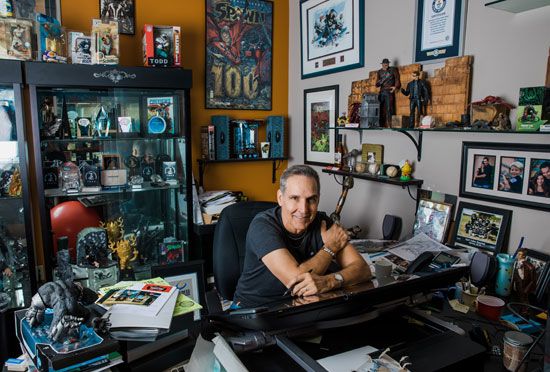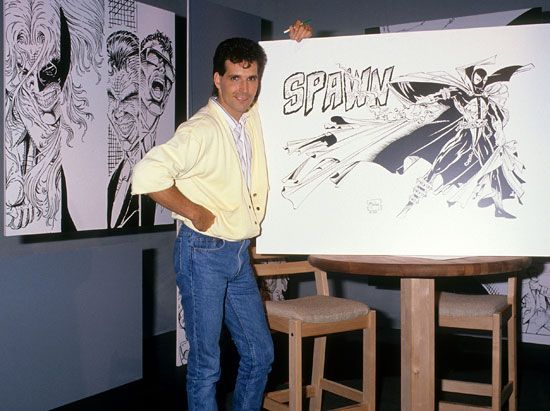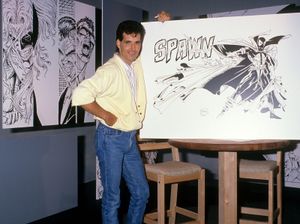Todd McFarlane
Our editors will review what you’ve submitted and determine whether to revise the article.
Todd McFarlane (born March 16, 1961, Calgary, Alberta, Canada) is a Canadian-born comic book illustrator who gained fame in the late 1980s for his work on the Marvel Comics series The Amazing Spider-Man and who in 1992 co-founded Image Comics, where he created the massively successful antihero Spawn. The first issue of the comic book featuring the antihero, Spawn no. 1, sold more than 1.7 million copies, making it almost instantly one of the top-selling independent comic books.
McFarlane spent most of his childhood in California. In 1975 he moved back to Calgary with his family and completed high school there. His two great loves were comic books and baseball. He played semiprofessional ball for a Seattle Mariners tournament team and tried out as a pitcher for a Toronto Blue Jays farm team. In January 1981 a baseball scholarship took him to Eastern Washington State University in Cheney, where he studied art and design.
McFarlane’s dream of pitching for the major leagues ended when he broke his ankle sliding into home plate. Having drawn comic characters for years, he started submitting drawings to comic book publishers. More than 700 rejection slips later, in March 1984 Marvel Comics offered him a temporary assignment on the obscure Scorpio Rose line. McFarlane completed his bachelor’s degree later that spring but stayed in Cheney with his fiancée, Wanda Kolomyjec. They married in July 1985. By December, when she graduated, Todd had a full-time job penciling on Infinity, Inc., for DC Comics.
The newlyweds moved to British Columbia. While McFarlane’s wife taught high school biology, he penciled The Incredible Hulk for Marvel Comics and did several one-time assignments, including a Batman issue for DC Comics and a Canadian anti-censorship benefit book, The True North (1988). His big break came with drawings and covers for the March 1988 to December 1989 issues of Marvel’s The Amazing Spider-Man. McFarlane thinned the superhero to spidery proportions, twisted him into wiry poses, and gave him large angular eyes. The Amazing Spider-Man jumped from ninth to first place in comic book sales.
McFarlane subsequently demanded and received his own Marvel title to write as well as draw. His first Spider-Man, released in June 1990, sold an unprecedented 2.5 million copies. While Spider-Man held its top ranking, McFarlane and Marvel argued over promotion and control. In August 1991 McFarlane left Marvel to form his own company. He and his wife moved to Portland, Oregon, with their baby daughter, Cyan. Early in 1992 McFarlane and other dissatisfied Marvel artists established Image Comics, an independent publishing company in which each artist kept control over the characters he or she created. In a break with comic book publishing tradition, artists made their own licensing decisions and reaped the profits individually.
McFarlane’s creation, Spawn, appeared in May 1992 and was an immediate success. As sales expanded, McFarlane introduced new characters and spun off several miniseries. In 1994 he and his wife moved to Arizona, had a second daughter, Kate, and introduced the first Spawn action figures from Todd Toys (later renamed McFarlane Toys). Having rejected licensing offers from larger toy companies so as to keep creative control, McFarlane made and sold 10 million action toys by 1997. Through Todd McFarlane Entertainment, McFarlane collaborated with New Line Cinema to produce the film Spawn, which opened across the United States in the summer of 1997. The adult-only animated Todd McFarlane’s Spawn series, produced for cable television by Todd McFarlane Entertainment, aired on HBO from 1997 to 1999.
In 1998 McFarlane co-directed and created an animated clip for the music video “Do the Evolution,” by Pearl Jam. He also co-directed and created animation for the music video “Freak on a Leash” by nu metal band Korn, for which he received the 2000 Grammy Award for best short form music video. He later produced animation for the comedy-drama The Dangerous Lives of Altar Boys (2002), as well as for several other music videos by prominent artists. In 2022 he created the comic book Patient Number 9, a fictional story about Ozzy Osbourne being trapped in an asylum; the comic accompanied the release of Osbourne’s 13th studio album of the same name.
















